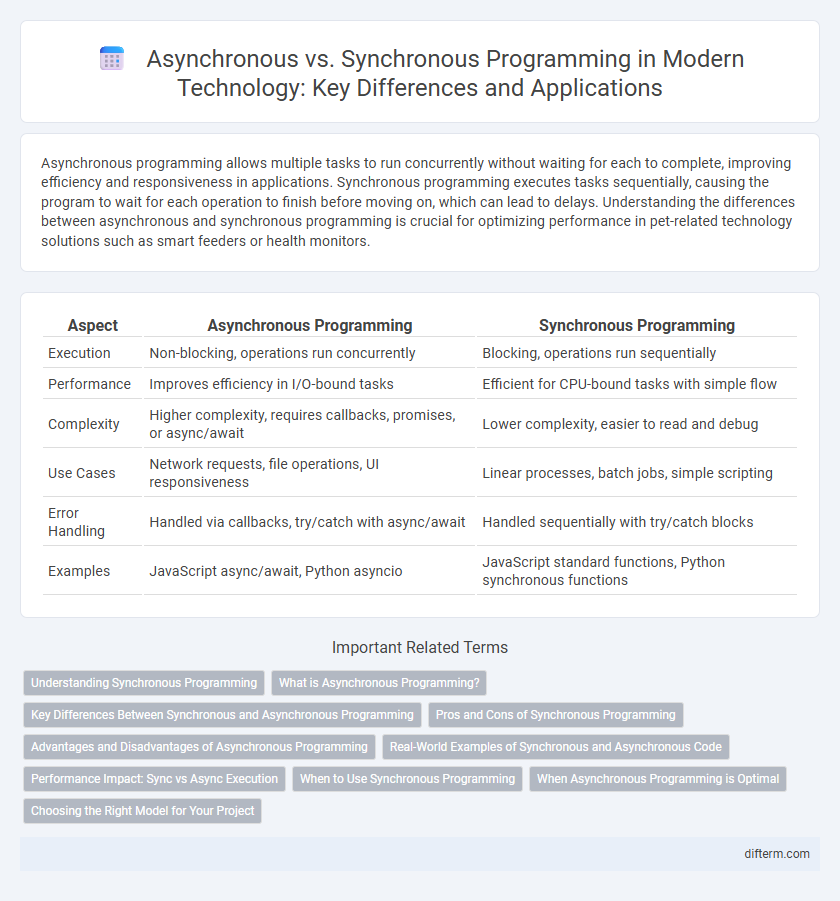Asynchronous programming allows multiple tasks to run concurrently without waiting for each to complete, improving efficiency and responsiveness in applications. Synchronous programming executes tasks sequentially, causing the program to wait for each operation to finish before moving on, which can lead to delays. Understanding the differences between asynchronous and synchronous programming is crucial for optimizing performance in pet-related technology solutions such as smart feeders or health monitors.
Table of Comparison
| Aspect | Asynchronous Programming | Synchronous Programming |
|---|---|---|
| Execution | Non-blocking, operations run concurrently | Blocking, operations run sequentially |
| Performance | Improves efficiency in I/O-bound tasks | Efficient for CPU-bound tasks with simple flow |
| Complexity | Higher complexity, requires callbacks, promises, or async/await | Lower complexity, easier to read and debug |
| Use Cases | Network requests, file operations, UI responsiveness | Linear processes, batch jobs, simple scripting |
| Error Handling | Handled via callbacks, try/catch with async/await | Handled sequentially with try/catch blocks |
| Examples | JavaScript async/await, Python asyncio | JavaScript standard functions, Python synchronous functions |
Understanding Synchronous Programming
Synchronous programming executes tasks sequentially, blocking the program flow until each operation completes. This approach simplifies debugging by ensuring a predictable execution order but can lead to inefficiencies in I/O-bound processes. Understanding synchronous programming is essential for grasping how traditional applications handle tasks before transitioning to more efficient asynchronous patterns.
What is Asynchronous Programming?
Asynchronous programming allows tasks to run concurrently without waiting for each operation to complete before starting the next, enhancing performance in I/O-bound processes. It utilizes callbacks, promises, or async/await syntax to handle operations like API calls, file reading, or database queries efficiently. This approach prevents blocking the main thread, enabling smoother user experiences and improved resource utilization in applications.
Key Differences Between Synchronous and Asynchronous Programming
Synchronous programming executes tasks sequentially, waiting for each operation to complete before starting the next, which can lead to blocking and inefficiency in time-sensitive applications. Asynchronous programming allows multiple tasks to run concurrently without waiting for previous tasks to finish, improving responsiveness and resource utilization in web development and real-time systems. The key differences lie in execution flow, with synchronous methods blocking the thread and asynchronous methods leveraging callbacks, promises, or async/await patterns to manage non-blocking operations.
Pros and Cons of Synchronous Programming
Synchronous programming offers simplicity and ease of debugging by executing tasks sequentially, ensuring predictable flow and easier error handling. It may cause inefficiencies in applications requiring high responsiveness or parallel processing, as tasks block the execution thread until completion. This blocking nature can lead to slower performance in I/O-heavy or real-time systems compared to asynchronous models.
Advantages and Disadvantages of Asynchronous Programming
Asynchronous programming enables non-blocking operations, allowing systems to handle multiple tasks concurrently, which improves performance and resource utilization in I/O-bound applications. It reduces latency and enhances user experience by preventing UI freezing in web and mobile applications, though it introduces complexity in debugging and requires careful management of concurrency to avoid race conditions. Despite these challenges, asynchronous patterns facilitate scalability in distributed systems and real-time data processing.
Real-World Examples of Synchronous and Asynchronous Code
Synchronous programming executes tasks sequentially, exemplified by traditional file reading operations where the program waits for the file to load before continuing. Asynchronous programming, used in web APIs like JavaScript's fetch or Node.js database queries, allows other processes to run concurrently while waiting for resource-intensive operations. This non-blocking behavior enhances application responsiveness and scalability in real-time systems such as chat applications or live data streaming.
Performance Impact: Sync vs Async Execution
Asynchronous programming improves performance by allowing multiple tasks to run concurrently without blocking the main thread, leading to better resource utilization and faster response times in I/O-bound operations. Synchronous programming executes tasks sequentially, causing potential delays as each operation waits for the previous one to complete, which can result in slower overall execution and decreased throughput. In high-latency environments, asynchronous execution drastically reduces idle wait times and enhances scalability compared to synchronous execution models.
When to Use Synchronous Programming
Synchronous programming is ideal for tasks that require sequential execution and immediate results, such as simple scripts or operations where processes depend on the completion of previous steps. It is preferred in environments with limited concurrency needs or when debugging code, as the linear flow simplifies tracing and error handling. Use synchronous programming when predictable execution order and straightforward control flow are critical for application stability and clarity.
When Asynchronous Programming is Optimal
Asynchronous programming is optimal in scenarios requiring high responsiveness and efficient resource utilization, such as web servers handling multiple simultaneous requests or applications performing I/O-bound operations like file access and network communication. It enables non-blocking execution, allowing other tasks to proceed without waiting for long-running processes to complete. This approach maximizes throughput and improves user experience in environments where latency and concurrency are critical.
Choosing the Right Model for Your Project
Choosing between asynchronous and synchronous programming depends on the project's performance requirements and resource availability; asynchronous programming excels in handling I/O-bound tasks with non-blocking operations, improving scalability and responsiveness. Synchronous programming suits CPU-bound tasks needing sequential execution, simplifying debugging and maintaining code clarity. Evaluating factors like latency tolerance, concurrency demands, and complexity helps determine the optimal model for efficient software development.
Asynchronous programming vs Synchronous programming Infographic

 difterm.com
difterm.com